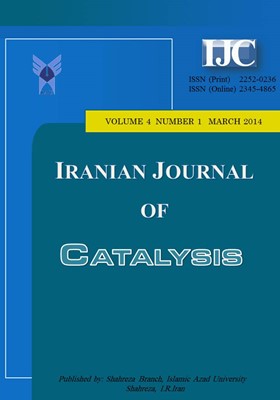Disulfide catalyzed the highly regioselective conversion of epoxides to halohydrins with elemental halogens
محورهای موضوعی : Iranian Journal of CatalysisHossein Eshghi 1 , Zaiddodine Pashandi 2 , Gholam Hossein Rounaghi 3 , Afsaneh Alipour 4 , Azadeh Shafaie 5
1 - Department of Chemistry, Faculty of Sciences, Ferdowsi University of Mashhad, Mashhad 91775-1436, Iran.
2 - Department of Chemistry, Faculty of Sciences, Ferdowsi University of Mashhad, Mashhad 91775-1436, Iran.
3 - Department of Chemistry, Faculty of Sciences, Ferdowsi University of Mashhad, Mashhad 91775-1436, Iran.
4 - Department of Chemistry, Faculty of Sciences, Ferdowsi University of Mashhad, Mashhad 91775-1436, Iran.
5 - Department of Chemistry, Faculty of Sciences, Ferdowsi University of Mashhad, Mashhad 91775-1436, Iran.
کلید واژه: Epoxides, methimazole, Ring Opening, Polyiodide, Halohydrins, Disulfide,
چکیده مقاله :
The regioselective ring opening of styrene oxide using elemental iodine and bromine in the presence of disulfides as new catalysts was studied. The conductivity titration and UV spectroscopy were used to study the interaction of iodine with these catalysts. The results indicate that disulfide 11 is efficient in polyiodide formation, and can catalyze this reaction in excellent yield and high regioselectivity. The complex [(11-disulfide)I]+.I3- is considered to be formed initially which could be bulkier by addition of excess of iodine in the course of the reaction. These bulky nucleophiles have a fundamental role in the high regioselectivity by attacking the less sterically hindered epoxide carbon.
[1] C. Laurence, C. M.J. El-Ghomari,, J.Y. Le Questel, M. Berthelot, R. Mokhlisse, J. Chem. Soc., Perkin Trans., 2 (1998) 1545-1552.
[2] M.C. Aragoni, M. Arca, F. Demartin, F.A. Devillanova, A. Garau, F. Isaia, V. Lippolis, G. Verani, J. Am. Chem. Soc., 124 (2002) 4538-4539.
[3] G. Roy, M. Nethaji, G. Mugesh, Org. Biomol. Chem., 4 (2006) 2883- 2887.
[4] G. Roy, G. Mugesh, Phosphorus, Sulfur, Silicon Relat. Elem., 180 (2005) 891-902.
[5] H. Eshghi, S.F. Tayyari, Z. Rezvani-Amin, H. Roohi. Bull. Korean Chem. Soc., 29 (2008) 51-56.
[6] H. Sharghi, A.R. Massah, H. Eshghi, K. Niknam, J. Org. Chem., 63 (1998) 1455-1461.
[7] H. Sharghi, M.M. Eskandari, Tetrahedron, 59 (2003) 8509-8514.
[8] H. Sharghi, Z. Paziraee, K. Niknam, Bull. Korean Chem. Soc., 23 (2002) 1611-1615.
[9] H. Eshghi, M. Bakavoli, H. Moradi, A. Davoodnia, Phosphorus, Sulfur, Silicon Relat. Elem., 184 (2009) 3110-3118.
[10] A. Kosari, M. Momeni, R. Parvizi, M. Zakeri, M.H. Moayed, A. Davoodi, H. Eshghi, Corros. Sci., 53 (2011) 3058-3067.
[11] M.I. Konaklieva, M.L. Dahi, E. Turos, Tetrahedron Lett., 33 (1992) 7093-7096
[12] E.J. Corey, D. J. Brunelle, Tetrahedron Lett., (1976) 3409-3412.
[13] A. Semnani, M. Shamsipur, J. Chem. Soc., Dalton Trans, (1996) 2215-2224.
[14] P. Deplano, J.R. Ferraro, M.L. Mercuri, E.F. Trogu, Coord. Chem. Rev., 188 (1999) 71-95.
[15] E.M. Nour, Spectrochim Acta Part A, 47 (1991) 743-747.
[16] E.M. Nour, L.H. Chen, J. Laane, J. Phys. Chem., 90 (1986) 2841-2846.
[17] L.J. Andrews, E.S. Prochaska, A. Loewenschuss, Inorg. Chem., 19 (1980) 463-465.
[18] R.E. Buckles, J.P. Yuk, A.I. Popov, J. Am. Chem. Soc., 74 (1952) 4379-4381.
[19] J.S. Bajwa, R.C. Anderson, Tetrahedron Lett., 32 (1991) 3021-3024.
[20] M. Chini, P. Crotti, C. Gardelli, F. Macchia, Tetrahedron, 48 (1992) 3805-3812.


